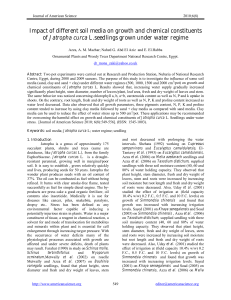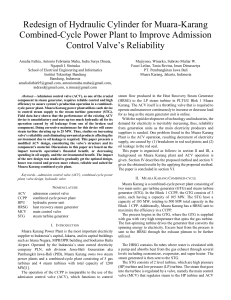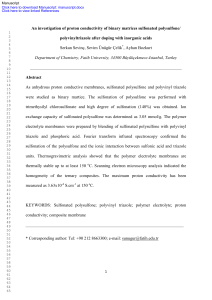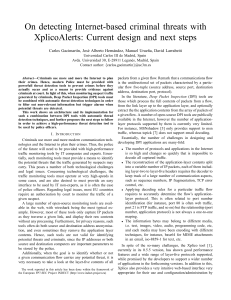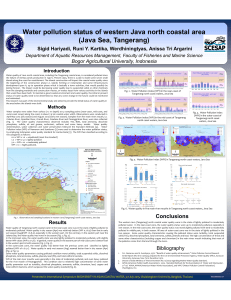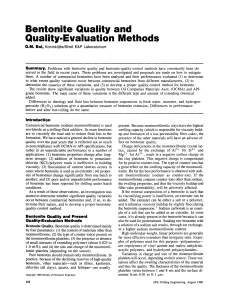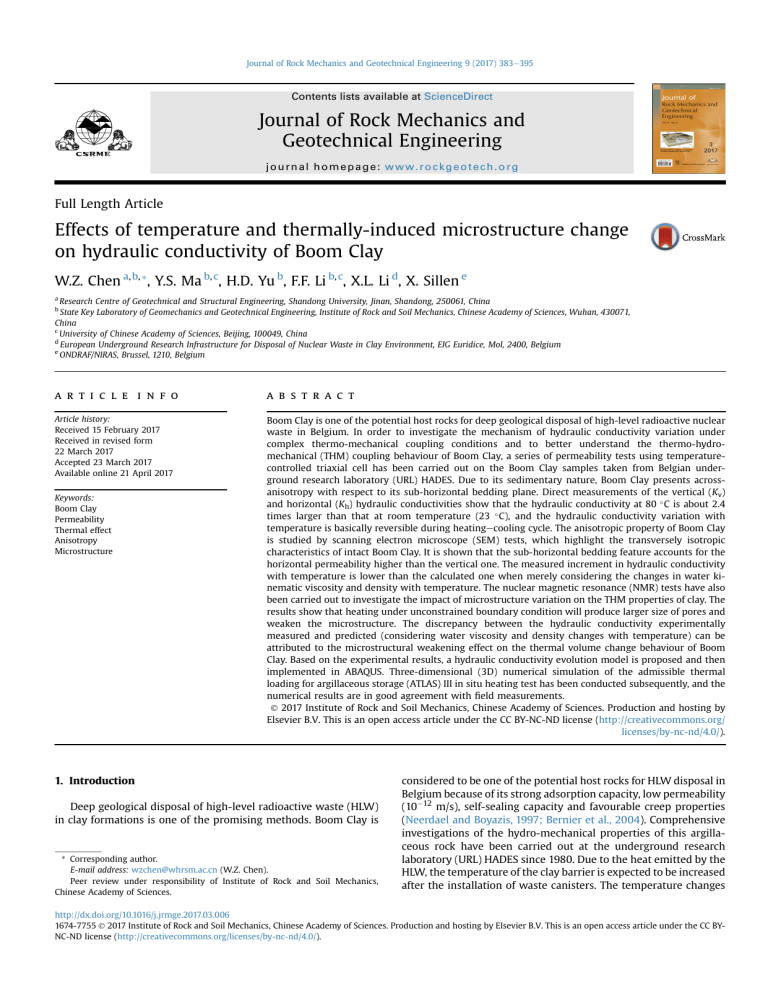
Journal of Rock Mechanics and Geotechnical Engineering 9 (2017) 383e395 Contents lists available at ScienceDirect Journal of Rock Mechanics and Geotechnical Engineering journal homepage: www.rockgeotech.org Full Length Article Effects of temperature and thermally-induced microstructure change on hydraulic conductivity of Boom Clay W.Z. Chen a, b, *, Y.S. Ma b, c, H.D. Yu b, F.F. Li b, c, X.L. Li d, X. Sillen e a Research Centre of Geotechnical and Structural Engineering, Shandong University, Jinan, Shandong, 250061, China State Key Laboratory of Geomechanics and Geotechnical Engineering, Institute of Rock and Soil Mechanics, Chinese Academy of Sciences, Wuhan, 430071, China c University of Chinese Academy of Sciences, Beijing, 100049, China d European Underground Research Infrastructure for Disposal of Nuclear Waste in Clay Environment, EIG Euridice, Mol, 2400, Belgium e ONDRAF/NIRAS, Brussel, 1210, Belgium b a r t i c l e i n f o a b s t r a c t Article history: Received 15 February 2017 Received in revised form 22 March 2017 Accepted 23 March 2017 Available online 21 April 2017 Boom Clay is one of the potential host rocks for deep geological disposal of high-level radioactive nuclear waste in Belgium. In order to investigate the mechanism of hydraulic conductivity variation under complex thermo-mechanical coupling conditions and to better understand the thermo-hydromechanical (THM) coupling behaviour of Boom Clay, a series of permeability tests using temperaturecontrolled triaxial cell has been carried out on the Boom Clay samples taken from Belgian underground research laboratory (URL) HADES. Due to its sedimentary nature, Boom Clay presents acrossanisotropy with respect to its sub-horizontal bedding plane. Direct measurements of the vertical (Kv) and horizontal (Kh) hydraulic conductivities show that the hydraulic conductivity at 80 C is about 2.4 times larger than that at room temperature (23 C), and the hydraulic conductivity variation with temperature is basically reversible during heatingecooling cycle. The anisotropic property of Boom Clay is studied by scanning electron microscope (SEM) tests, which highlight the transversely isotropic characteristics of intact Boom Clay. It is shown that the sub-horizontal bedding feature accounts for the horizontal permeability higher than the vertical one. The measured increment in hydraulic conductivity with temperature is lower than the calculated one when merely considering the changes in water kinematic viscosity and density with temperature. The nuclear magnetic resonance (NMR) tests have also been carried out to investigate the impact of microstructure variation on the THM properties of clay. The results show that heating under unconstrained boundary condition will produce larger size of pores and weaken the microstructure. The discrepancy between the hydraulic conductivity experimentally measured and predicted (considering water viscosity and density changes with temperature) can be attributed to the microstructural weakening effect on the thermal volume change behaviour of Boom Clay. Based on the experimental results, a hydraulic conductivity evolution model is proposed and then implemented in ABAQUS. Three-dimensional (3D) numerical simulation of the admissible thermal loading for argillaceous storage (ATLAS) III in situ heating test has been conducted subsequently, and the numerical results are in good agreement with field measurements. Ó 2017 Institute of Rock and Soil Mechanics, Chinese Academy of Sciences. Production and hosting by Elsevier B.V. This is an open access article under the CC BY-NC-ND license (http://creativecommons.org/ licenses/by-nc-nd/4.0/). Keywords: Boom Clay Permeability Thermal effect Anisotropy Microstructure 1. Introduction Deep geological disposal of high-level radioactive waste (HLW) in clay formations is one of the promising methods. Boom Clay is * Corresponding author. E-mail address: [email protected] (W.Z. Chen). Peer review under responsibility of Institute of Rock and Soil Mechanics, Chinese Academy of Sciences. considered to be one of the potential host rocks for HLW disposal in Belgium because of its strong adsorption capacity, low permeability (1012 m/s), self-sealing capacity and favourable creep properties (Neerdael and Boyazis, 1997; Bernier et al., 2004). Comprehensive investigations of the hydro-mechanical properties of this argillaceous rock have been carried out at the underground research laboratory (URL) HADES since 1980. Due to the heat emitted by the HLW, the temperature of the clay barrier is expected to be increased after the installation of waste canisters. The temperature changes http://dx.doi.org/10.1016/j.jrmge.2017.03.006 1674-7755 Ó 2017 Institute of Rock and Soil Mechanics, Chinese Academy of Sciences. Production and hosting by Elsevier B.V. This is an open access article under the CC BYNC-ND license (http://creativecommons.org/licenses/by-nc-nd/4.0/). 384 W.Z. Chen et al. / Journal of Rock Mechanics and Geotechnical Engineering 9 (2017) 383e395 would increase the hydraulic conductivity of Boom Clay and consequently compromise the favourable properties of clay formation as a natural barrier for migration of radionuclide. A better understanding of this issue is thus important for the repository performance and safety assessments. The thermal effect on hydraulic conductivity of Boom Clay has been widely studied. Sultan (1997) observed that the hydraulic conductivity of Boom Clay was up to two times larger when the temperature changed from 35 C to 60 C. Delage et al. (2000) reported that the hydraulic conductivity of Boom Clay increased from 2.5 1012 m/s to 6.2 1012 m/s with temperature increasing from 20 C to 90 C. In order to assess the self-sealing capacity of damaged Boom Clay, Monfared et al. (2012) and Chen et al. (2014) investigated the thermal effect on hydraulic conductivity of Boom Clay pre-damaged by shearing and artificial fracture. They found that the shear band or artificial fracture does not significantly affect the permeability, because Boom Clay presents a good self-sealing capacity. Nevertheless, the results focussing on Boom Clay are still limited to enable a refined interpretation of the large-scale in situ PRACLAY heater test in Belgian URL HADES (Li et al., 2010). A number of studies (Wemaere et al., 1997; Bastiaens and Demarche, 2003; Dehandschutter et al., 2004; Bastiaens et al., 2007; Piriyakul and Haegeman, 2009; Chen et al., 2011; Lima, 2011) indicate that Boom Clay presents anisotropic properties. Dehandschutter et al. (2005) observed bedding planes of fractured Boom Clay by scanning electron microscope (SEM) observations. Indeed, in the presence of sub-horizontal bedding planes, Boom Clay can be considered as a transversely isotropic geomaterial (Yu et al., 2014). The anisotropic property of permeability of Boom Clay has been investigated by in situ experiments (Bastiaens et al., 2006). For this, the anisotropic properties are further investigated by more laboratory experiments in this study. In most above-mentioned studies, the increase in hydraulic conductivity with temperature has been considered due to the decrease in viscosity of fluid (Habibagahi, 1977; Cho et al., 1999; Delage et al., 2011). However, the changes of hydraulic conductivity with temperature are not only influenced by the changes of water properties, but also by the thermal effect on soil-water interaction at microstructural level (Towhata et al., 1993; Romero et al., 2001; Villar and Lloret, 2004). As the temperature increases, the thermal effects would alter clay fabric (Romero et al., 2001), produce larger voids between clay particles (Pusch and Güven, 1990; Pons et al., 1994; Thomas et al., 1994), change the effective flow cross-sectional area of porous channels (Ye et al., 2013, 2014), and degenerate the absorbed water into free water (Derjaguin et al., 1986). Consequently, there are different interpretations on the discrepancy of hydraulic conductivity between the test results and the predictions by considering water properties changing with temperature (Table 1). Towhata et al. (1993) analysed the influence of temperature on the permeability of MC clay and bentonite, and concluded that the increment of measured hydraulic conductivity with temperature was higher than the calculated one by using properties of free and pure water. They attributed this discrepancy to the degeneration of absorbed water into free water at elevated temperatures, which may result in easier seepage through the clay. On the other hand, Houston and Lin (1987) measured hydraulic conductivity values of illite, and Villar and Lloret (2004) conducted hydraulic conductivity test of bentonite at different temperatures. Their results showed that the increase in hydraulic conductivity due to temperature evolution was smaller than the prediction as per water viscosity change. They suggested that this may account for the soil densification by thermal consolidation, and the variation of hydraulic conductivity with temperature may depend on the type of material. Romero et al. (2001) gave similar results for unsaturated Boom Clay and attributed this discrepancy to the clay fabric alteration and porosity redistribution by thermo-chemical effects. Wan (2010) investigated the thermal effects on the microstructure of the GMZ01 bentonite using mercury intrusion porosimetry (MIP) technique. Results showed that, under confined conditions, the pore structure of the saturated GMZ01 bentonite changes slightly with temperature. However, it reveals that the thermal effect on microstructure of clay has not been fully understood to date, due to significant effect of microstructure on thermo-hydro-mechanical (THM) properties of clay. The nuclear magnetic resonance (NMR) technique is used to investigate the microstructure change behaviour of clay without disturbing the tested samples (Bird et al., 2005; Bayer et al., 2010). This paper first presents the experimental results obtained using permeability tests considering heatingecooling cycle, as well as the SEM and NMR tests conducted on heated Boom Clay samples. These laboratory tests results help to understand the thermal effect on hydraulic conductivity. The anisotropy of hydraulic properties of Boom Clay as well as the importance of the thermally-induced microstructure change and its effect on the THM behaviour of Boom Clay is concerned. Next, based on the experimental results, a model for hydraulic conductivity of Boom Clay in relation to temperature is proposed and then implemented in ABAQUS through USDFLD subroutine. Finally, a three-dimensional (3D) numerical simulation of the admissible thermal loading for argillaceous storage (ATLAS) III in situ heating test is conducted, and the numerical results are compared with in situ measurements. 2. Materials and experimental investigations 2.1. Boom Clay samples The Boom Clay samples are extracted at a depth of 223 m and at dozens of metres deep from the sidewall of connecting gallery of the URL HADES. Boom Clay is a dense plastic clay, with a total porosity of around 39% and water content of 24%e30%. The dominant fraction (around 60%) contains illite, smectite, illite-smectite mix layer and kaolinite. The non-clay mineral is mainly composed of quartz (25%), feldspar with a little pyrite, and calcite (Yu et al., 2012). Table 1 Review of comparison of hydraulic conductivity values measured and predicted on the basis of water properties changing with temperature. Source Clay type Temperature range ( C) Test method Test result Reason of discrepancy Towhata et al. (1993) 20e90 4e200 Measured < predicted Thermally-induced degeneration of absorbed water into free water Soil densified by thermal consolidation Villar and Lloret (2004) Bentonite 20e80 Measured < predicted Dependency on the type of material Romero et al. (2001) Unsaturated Boom Clay 22e80 Calculated from cv measurements Calculated from cv measurements Constant head permeability tests Transient method Measured > predicted Houston and Lin (1987) Bentonite and MC clay Illite Measured < predicted Thermally-induced clay fabric modification and porosity redistribution W.Z. Chen et al. / Journal of Rock Mechanics and Geotechnical Engineering 9 (2017) 383e395 2.2. Experimental investigations 2.2.1. Permeability tests Permeability tests are performed in a temperature-controlled triaxial testing machine (see Fig. 1), which is designed for investigating the THM characteristics of Boom Clay. The device consists of a conventional triaxial apparatus and a temperature controller system. The confining pressure and the back pressure are applied by two hydraulic pressure generators and measured through hydraulic pressure transducers. The heater coil is installed around the outside of the cell. The power supplied to the coil is automatically adjusted by the temperature controller. Temperature is measured by the temperature sensor submersed in the cell fluid. This system allows a maximum temperature of 100 C and an accuracy of 0.5 C. Smaller samples with standard diameter (38 mm) but reduced height (10 mm) are used in order to ensure a measurable flow. The hydraulic conductivities of Boom Clay measured through various testing techniques exhibit similar values in the order of 1012 m/s (Yu et al., 2013). Taking into account the anisotropy of Boom Clay, we trim the samples manually with the axis parallel and perpendicular to the bedding plane, respectively. Samples resaturation has been done using in situ effective stress as proposed by Yu et al. (2012) before permeability measurement. The saturation duration for Boom Clay is about 20 d in total when a satisfactory value of the coefficient of Skempton B (greater than 0.85) is obtained. Permeability tests are carried out during a heatingecooling cycle (23 C (room temperature)/40 C/60 C /80 C/60 C/40 C/23 C) at hydrostatic pressure (s1 ¼ s2 ¼ s3 ¼ 2.5 MPa, more or less representative of the in situ effective stress). The samples are firstly gradually loaded (40 kPa/h) to the in situ effective stress and then heated/cooled down (0.3 C/ h) following the predefined heatingecooling cycle. These rates are defined during an experimental benchmark exercise on Boom Clay and found to be slow enough to ensure temperature and pore pressure equilibrium inside the sample. The back pressure is 385 maintained at 1 MPa at the bottom and atmospheric pressure at the top of the sample. The high back pressure is found necessary in order to obtain a satisfactory precision in the measurement of flow rate and, hence, of the permeability (Delage et al., 2000). The injection fluid for the tests is the synthetic Boom Clay water (SBCW). 2.2.2. SEM tests Two kinds of samples (parallel/perpendicular to bedding plane) have been investigated using environmental SEM techniques in order to study the anisotropy properties of Boom Clay. The environmental SEM techniques allow for imaging of fresh samples under undried and non-vacuum condition that effectively prevents the development of desiccation cracks and unequal swelling of the clay particles. As the samples are extracted at tens of metres deep from the sidewalls with special cares to prevent desaturation, the samples can be considered as representative of the undisturbed Boom Clay materials. 2.2.3. NMR tests NMR tests allow providing the information about the water content and pore distribution of soil and are realised in a NMR analyser, as illustrated in Fig. 2. The NMR analyser is mainly composed of permanent magnet, sample tube, radio frequency (RF) system, and data collecting and analysing system. The strength of the permanent magnet is 0.52 T and the magnet temperature is maintained at (32 0.01) C in order to ensure the uniformity and stability of main magnetic field. Its design, operation and service condition were discussed in detail by Tian and Wei (2014). The dimensions of the sample in the NMR analyser are the same as those for the permeability tests. Sample resaturation has been also done following the same procedure as the permeability tests. After resaturation, the sample is covered by preservative film and heated at 23 C, 40 C, 60 C, and 80 C, respectively. The equilibrium time for each temperature level is about 2 h. Then the sample is moved rapidly to the sample tube for NMR tests. Bayer et al. Fig. 1. Schematic diagram of the temperature-controlled triaxial cell. 386 W.Z. Chen et al. / Journal of Rock Mechanics and Geotechnical Engineering 9 (2017) 383e395 Fig. 2. Schematic diagram of the NMR analyser. a 1 zr2 T2 R (1) The vertical (Kv) and horizontal (Kh) hydraulic conductivities at room temperature are 1.73 1012 m/s and 5.01 1012 m/s, respectively, which fall in the range of the in situ hydraulic conductivity measured by Bastiaens et al. (2006), 5.0 23 C (Heating) (Heatinig) 4.5 40 40 C C (Heating) (Heatinig) 4.0 Water injected (mL) (2010) summarised the applications of NMR technique in soil science. The measured signal of NMR test is called the free induction decay (FID). The FID curve is determined by using Carr-PurcellMeiboom-Gill (CPMG) sequence in the present study. The FID curve contains rich information about the water content and wateroccupied pore-size distribution of the porous medium. The initial FID peak value is directly proportional to the number of water protons in the sample (Ishizaki et al., 1996). Hence the initial FID peak measurements can determine water content of the sample. Moreover, the shape of FID curve is associated with the transverse relaxation time (T2) of pore water protons. The relaxation time T2 distribution curve can be obtained by inverse Laplace transform. The peak area (dimensionless) under T2 distribution curve represents the water content of corresponding T2 range (Bird et al., 2005). The transverse relaxation time T2 of the water protons is proportional to the water-filled pore size, which means that water in small pores relaxes faster than that in large pores: 60 C (Heating) (Heatinig) 3.5 80 C (Heating) (Heatinig) 3.0 60 C (Cooling) (Coolin g) 2.5 40 C (Cooling) (Coolin g) 2.0 23 C (Cooling) (Coolin g) 1.5 1.0 0.5 (1) 0.0 0 2 4 6 8 10 12 Time (h) where R is the pore radius, r2 is the transverse relaxivity, and a is the shape factor (1, 2, and 3 for planar, cylindrical and spherical pore geometry, respectively) (Godefroy et al., 2001). Based on the above theory, the T2 distribution curve can reflect the information about the water content and pore distribution of soil. (a) 3.5 23 C (Heating) (Heating) 40 C (Heating) (Heating) 3.0 3. Test results and discussions 3.1. Permeability tests Although the reduced sample height is used in association with high water pressure gradient applied, duration of about 10 h is still needed to achieve the target steady water flow. The steady flow duration of each temperature level is set to 10 h. The steady water flow characteristic at different temperatures is presented in Fig. 3. It can be observed that a satisfactory linear relationship is obtained for each level of temperature. The injected water volume within the same duration increases with increasing temperature, indicating higher permeability with respect to higher temperature. The hydraulic conductivities are calculated by Darcy’s law. The variations in hydraulic conductivity with temperature are shown in Fig. 4. It can be seen that: Water injected (mL) 60 C (Heating) (Heating) 2.5 80 C (Heating) (Heating) 60 C (Cooling) (Coolin g) 2.0 40 C (Cooling) (Coolin g) 1.5 23 C (Cooling) (Coolin g) 1.0 0.5 0.0 0 2 4 6 8 10 12 Time (h) (b) Fig. 3. Injected water flow-time relationships of steady stage at each temperature level. (a) Flow direction parallel to bedding plane; and (b) Flow direction perpendicular to bedding plane. W.Z. Chen et al. / Journal of Rock Mechanics and Geotechnical Engineering 9 (2017) 383e395 387 Table 2 Variations of viscosity and density of pure water with temperature. Temperature ( C) Viscosity (103 Pa s) Density (g/cm3) 23 40 60 80 0.9579 0.656 0.4688 0.3565 0.9985 0.9927 0.9845 0.9742 viscosity and density (Table 2), taking the experimentally measured hydraulic conductivity at room temperature as a starting point. Fig. 6 shows the comparison between the values determined by experiment and prediction, which indicates that the increase in measured hydraulic conductivity is lower than that by prediction. Fig. 5. Variations of the intrinsic permeability of Boom Clay with temperature. Fig. 4. Variations in hydraulic conductivity of Boom Clay with temperature. (a) Horizontal; and (b) Vertical. i.e. (1.7e2.3) 1012 m/s for Kv and (4.1e5.2) 1012 m/s for Kh. (2) The hydraulic conductivity at 80 C is about 2.4 times larger than that at room temperature, and a linear relationship between temperature and hydraulic conductivity basically can be found regardless of anisotropy property. (3) There is a positive and basically reversible correlation between hydraulic conductivity and temperature during heatingecooling cycle. In order to decouple the effect of water properties change with temperature from other factors affecting the permeability of Boom Clay during heatingecooling cycle, the intrinsic permeability values k are calculated based on the measured hydraulic conductivity: k ¼ K mw rw g (2) where K is the hydraulic conductivity; mw and rw denote the water viscosity and density, respectively; and g is the gravitational acceleration. The thermal variations of viscosity and density of “pure water” are available in science handbooks (Table 2). Fig. 5 shows the variations of the intrinsic permeability with temperature. It can be observed that both the vertical and horizontal intrinsic permeabilities decrease by approximately 10% (for all tests) during the heating phase, and then they increase slightly during the cooling phase. Additionally, this phenomenon may be attributed to the thermal volume change behaviour of Boom Clay. The plastic thermal contraction of samples during the heating phase results in a decrease in the intrinsic permeability. The variation of the hydraulic conductivity with temperature is also predicted by considering only the variation of pore water Fig. 6. Comparisons of hydraulic conductivity values determined experimentally and predicted on the basis of water viscosity and density change. (a) Horizontal; and (b) Vertical. 388 W.Z. Chen et al. / Journal of Rock Mechanics and Geotechnical Engineering 9 (2017) 383e395 This also implies that other factors including the water properties change may contribute to the hydraulic conductivity increase with temperature. This will be investigated by NMR tests and discussed in Section 3.3. 3.2. SEM tests Fig. 7 shows the microstructure of Boom Clay perpendicular to the bedding plane. The clay particles contact with each other in edge-to-face or face-to-face manners, and the clay presents the bending flaky structures (Fig. 7a). The diameter of flaky structures is about dozens of microns, and composed of smaller flaky particles. The diameter of flaky particles is only a few microns (Fig. 7b). These results were also observed by Yu et al. (2012) on intact Boom Clay sample. Fig. 8 shows the microstructure of Boom Clay parallel to the bedding plane. The apparent bedding plane, which mainly results from the sediment process, is observed in SEM images. Dehandschutter et al. (2005) observed a similar microstructure of fractured Boom Clay samples. Tens of microns long and about 2 microns wide long-strip-shaped pores have been observed between clay particles (Fig. 8b). These discontinuities which linearly arrange long-strip-shaped pores form elongated pore zone between adjacent bedding plane (Fig. 8a). Significant difference can be seen between the SEM images perpendicular and parallel to bedding plane. Compared to the well-developed alignment of the clay particles in Fig. 8, the clay particles in Fig. 7 are more irregular. Moreover, the pore shapes are different from two perpendicular and parallel directions with respect to the bedding plane. The presence of the bedding plane explains the transversely isotropic properties of Boom Clay, and these discontinuities elongating shape pores (Fig. 8) highlight the high horizontal permeability along the bedding plane (Fig. 5). 3.3. NMR tests Fig. 9 shows the thermal effect on the T2 distribution of saturated Boom Clay. The unchanged peak area of four curves demonstrates that the sample keeps saturated during the whole test (Bird et al., 2005). Moreover, the T2 distribution curves move to right in parallel with the increasing temperature (Fig. 9), indicating an increase in the relaxation time T2. The increasing relaxation time T2 means that the water-occupied pores size in saturated Boom Clay becomes larger with the increasing temperature. These results are similar with the previous results by X-ray diffraction technique (Pons et al., 1994; Thomas et al., 1994) and electron microscopic examination (Pusch and Güven, 1990), showing that heating produces larger voids among clay particles. It is worth noting that the above-mentioned phenomena occur when clays are heated under unconfined condition. Consequently, the larger internal particle Fig. 7. Microstructure of Boom Clay perpendicular to the bedding plane. (a) 500; and (b) 2000. Fig. 8. Microstructure of Boom Clay parallel to the bedding plane. (a) 500; and (b) 2000. W.Z. Chen et al. / Journal of Rock Mechanics and Geotechnical Engineering 9 (2017) 383e395 389 Fig. 9. Transverse relaxation time distribution curves of water in saturated Boom Clay. spaces produced by heating would lead to microstructural weakening and decrease in stiffness. However, for the THM coupled permeability tests, the samples are heated under hydrostatic stress. The samples would be compacted due to the thermally-induced microstructural weakening and decrease in stiffness. Therefore, the measured hydraulic conductivity is lower than predicted one (Fig. 6) and the decrease of the intrinsic permeability (Fig. 5) is induced due to the variation of void ratio with temperature. This means that water viscosity and density would affect the hydraulic conductivity in addition to the thermal volume change behaviour of Boom Clay. 4. Numerical simulation of ATLAS III in situ heating test Based on the experimental results, a hydraulic conductivity evolution model is proposed and implemented in ABAQUS by USDFLD subroutine. The USDFLD subroutine is designed to update the parameters at all material points of elements from the start of the increment. A 3D numerical simulation of the ATLAS III in situ heating test has been conducted to validate this model. 4.1. A model for predicting hydraulic conductivity of Boom Clay based on experimental studies The experimental results show that not only the water viscosity and density would affect the hydraulic conductivity of Boom Clay, but also affect the thermal volume change behaviour. As a porous medium, the variation of the void ratio of Boom Clay is controlled by the deformation of skeleton: De ¼ D Vp Vs (3) ¼ DVp De Vs De e e0 ¼ ¼ ¼ Vs ð1 þ e0 Þ 1 þ e0 Vs ð1 þ e0 Þ 1 þ e0 1 n0 1 þ 3v (5) where n is the porosity, and n0 is the initial porosity. Based on the Kozeny-Carman equation, the expression of the hydraulic conductivity under constant temperature is K ¼ C g n3 mw rw ð1 nÞ2 S2 G2s (4) where e0 is the initial void ratio, and e is the void ratio. Based on Eq. (4), the porosity can be obtained: (6) where C is a constant and influenced by the tortuosity and shape of the flow channels; S and Gs denote the mass specific surface area and the specific weight of solids, respectively. Substituting Eq. (5) into Eq. (6) to consider the thermal effect on the hydraulic conductivity and assuming that the C, g, S and Gs in Eq. (6) are constant, the hydraulic conductivity of Boom Clay varies indirectly with temperature and the volumetric strain can be obtained: K ¼ KðT0 Þ rw ðT0 Þmw ðT0 Þ ð3 v þ n0 Þ3 rw ðTÞmw ðTÞ n30 ð1 þ 3 v Þ (7) where T0 is the initial temperature; K(T0) is the hydraulic conductivity at initial temperature; mw ðT0 Þ and rw ðT0 Þ are the water dynamic viscosity in Pa s and the water density in g/cm3 at initial temperature, respectively. The dynamic viscosity mw ðTÞ and density rw ðTÞ of water decrease with elevated temperature T. The following expressions are adopted to describe the variations of dynamic viscosity and density with temperature (Gong, 2015): mw ¼ 2:9 1011 T 4 9:17 109 T 3 þ 106 T 2 5:56 1011 T þ 1:7862 103 where De is the increment of void ratio, Vp is the pore volume, and Vs is the solid volume. Assuming that the clay particles are incompressible, the volume strain 3 v can be obtained as 3v n ¼ 1 rw ¼ 5:5 106 T 2 þ 2:28 105 T þ 0:99997 (8) (9) 4.2. The ATLAS III in situ heating test The ATLAS in situ heating test series have been performed since 1992 by SCK$CEN, which aimed at assessing the THM effects on the 390 W.Z. Chen et al. / Journal of Rock Mechanics and Geotechnical Engineering 9 (2017) 383e395 Boom Clay for hosting heat-emitting HLW. The ATLAS III in situ heating test had been performed from April 2007 to April 2008 to obtain a more accurate picture of the pore water pressure and broaden the THM characterisation of the Boom Clay at different temperature levels (Chen et al., 2011). The ATLAS III test consists of a horizontal heater borehole (AT89E, 19 m long, 160 mm in internal diameter; heater section runs from 11 m to 19 m deep), three horizontal (AT85E, AT93E and AT98E) and a downward inclined (AT97E) observation boreholes. The temperature sensors and piezometer filters were installed in Fig. 10. Schematic diagrams of instrumentation of the ATLAS III in situ heating test. (a) Spatial location of the 6 boreholes; (b) Horizontal view; and (c) Vertical view. W.Z. Chen et al. / Journal of Rock Mechanics and Geotechnical Engineering 9 (2017) 383e395 391 the AT85E (15.3 m long, 60 mm in internal diameter), AT93E (15.3 m long, 60 mm in internal diameter) and AT98E (21 m long, 100 mm in internal diameter) to measure the temperature and pore pressure, respectively. However, the AT97E (21 m long, 40 mm in internal diameter) only allows the temperature measurement. Fig. 10 shows the test field of ATLAS III. The specifications and location of sensors in the boreholes are shown in Table 3. The heater was switched on from April 2007 to April 2008 with a stepwise power increase (see Fig. 11), followed by an instantaneous shutdown. 4.3. 3D finite element modelling for ATLAS III in situ heating test The geometry and mesh of the 3D modelling are illustrated in Fig. 12. The computational domain covers 60 m in the direction parallel to the axis of the heater borehole, 40 m in the direction perpendicular to the axis of the heater borehole (both horizontal and vertical planes). It consists of 355,350 elements and 371,904 nodes. The actual central steel tube (19 m long, 95 mm in external radius and 15 mm in thickness) is included in the geometry. The impermeable characteristic of the steel is considered by using 294 thermo-mechanical coupled elements (C3D8T), and the heater is attached to its innermost 8 m-long part. The THM coupled elements (C3D8PT) are used to simulate the THM behaviours of Boom Clay. The thermo-elastoplastic damage constitutive model based on the Drucker-Prager Cap model proposed by Gong (2015) is verified to capture the mechanical behaviours of Boom Clay at various temperatures. It is therefore used in the hydraulic conductivity model for numerical simulations proposed in this paper. The basic THM coupling theories for deformable saturated porous medium is based on the momentum conservation equation, mass conservation equation, energy conservation equation, constitutive equations and the Terzaghi’s effective stress principle (Gong, 2015). ABAQUS solves these equations in a fully coupled manner. The initial conditions are described as following: sZZ ¼ rgz is the initial vertical stress in Z-direction, sXX ¼ lX sZZ is the initial horizontal stress in X-direction, and sYY ¼ lY sZZ is the initial horizontal stress in Y-direction. The lateral total pressure coefficient lX ¼ lY ¼ 0:85. The pore pressure has been initialised according to uw ¼ gw z, where gw is the unit weight of water. The initial temperature is 16.6 C. The boundary conditions are described as follows. On the top surface of the model, vertical stress equal to the weight of the Table 3 Summary of the instrumented sensors for the ATLAS III in situ test. Borehole Sensor no. Distance to borehole entrance (m) Sensor type AT85E PP-AT85E TC-AT85E PP-AT93E TC-AT93E TC-AT97E1-12 TC-AT98E1 TC-AT98E2 TC-AT98E3 TC-AT98E4 TC-AT98E5 TC-AT98E6 TC-AT98E7 TC-AT98E8 TC-AT98E9 TC-AT98E10 PP-AT98E1 PP-AT98E2 PP-AT98E3 14.64 15.04 14.64 15.04 21-10 20 19 17 16 15 14 13 11 10 9 19 15 11 Piezometer Temperature Piezometer Temperature Temperature Temperature Temperature Temperature Temperature Temperature Temperature Temperature Temperature Temperature Temperature Piezometer Piezometer Piezometer AT93E AT97E AT98E sensor sensor sensor sensor sensor sensor sensor sensor sensor sensor sensor sensor sensor Fig. 11. Heating procedure of ATLAS III in situ heating test. overlying strata is applied. On the right surface of the model, symmetrical boundary condition is imposed. The normal deformation is fixed on other surfaces. All boundaries are impervious with the exception of symmetrical boundary condition. The impermeable characteristic of the steel tube is considered by using impermeable element. All boundaries except the steel tube surfaces where the heater is located are defined to be adiabatic. The THM parameters of the Boom Clay are presented in Table 4 (Gong, 2015). When considering transversely isotropy, higher values of Young’s modulus, Poisson’s ratio, thermal conductivity and hydraulic conductivity in the horizontal plane (Eh0, nhh, Kh(T0), lh) than those in the vertical plane (Ev0, nvh, Kv(T0), lv) are used. 4.4. Comparison between numerical results and in situ measurements 4.4.1. Temperature evolution The temperature sensors in boreholes AT85E and AT93E are placed at a depth of 15 m, and those in boreholes AT97E and AT98E are placed at the depths of 12 m and 10 m, respectively (Table 3). The comparisons between measured and simulated temperatures are shown in Figs. 13e15. As shown in Fig. 13, the maximum temperature change in borehole AT93E (24 C) is larger than that in borehole AT85E (22 C) due to the shorter distance of AT93E to the heater tube. The decrease in temperature is only visible 2 d after switching off the heater. The maximum temperature change of sensors in borehole AT98E is only 13 C (Fig. 14). Moreover, temperatures in borehole AT98E show a delay of the temperature decrease after switching off the heater. The furthest temperature sensor TC-AT98E10 starts to drop nearly 2 months after switching off the heater. Temperatures in the inclined borehole AT97E (Fig. 15) show a similar delay phenomenon. The maximum temperature change of sensors is determined by its distance to the midpoint of heater tube. Thermal convection can be neglected in Boom Clay, as a kind of low-permeability dense plastic clay (1012 m/s). Thermal conduction is the determinant way of heat transfer (Gens Sole et al., 2007). As shown in Figs. 13e15, the numerical results are in good agreement with in situ experimental results. 4.4.2. Thermally-induced pore pressure variation The piezometers in boreholes AT85E and AT93E are used to measure the pore pressure parallel to bedding plane at a depth of 14.6 m. There are three piezometers in borehole AT98E to measure the pore pressures parallel to bedding plane at the depths of 11 m (PP-AT98E3), 15 m (PP-AT98E2) and 19 m (PP-AT98E1), respectively. 392 W.Z. Chen et al. / Journal of Rock Mechanics and Geotechnical Engineering 9 (2017) 383e395 Fig. 12. 3D finite element mesh in the modelling of ATLAS III in situ heating test. Table 4 THM coupled parameters for Boom Clay (Gong, 2015). Young’s modulus (MPa) Eh0 Ev0 1400 700 Thermal conductivity (W/(m K)) lh lv 2.33 1.77 Cohesion, c0 (MPa) 0.3 Friction angle, 40 ( ) 15 Hydraulic conductivity (m/s) Poisson’s ratio Kh(T0) Kv(T0) nhh nvh 6 1012 3 1012 0.25 0.125 Dry density (kg/m3) Porosity, n0 (%) Specific heat capacity (J/(kg K)) 1640 39 740 Thermal expansion Density of pore water, Viscosity of pore rw ðT0 Þ (kg/m3) water, mw ðT0 Þ (Pa s) coefficient (K1) Specific heat capacity of pore water (J/(kg K)) Thermal conductivity of Thermal expansion coefficient of pore water (W/(m K)) pore water (K1) 1 105 4200 0.57 999 1.101 103 These three piezometers are in the symmetric plane perpendicular to the heated section of borehole AT89E and pass through its startpoint, midpoint and endpoint. The mechanism underlying the hydraulic behaviour is a competition between the generation of pore pressure by the differential thermal expansion of liquid and solid Fig. 13. Comparisons of measured and simulated temperature changes in boreholes AT85E and AT93E. 3.3 104 and the dissipation of pore pressure, the rate of which is mainly controlled by the value of permeability (Gens Sole et al., 2007). The comparisons between measured and simulated pore pressure changes in sensors PP-AT85E and PP-AT93E are shown in Fig. 16. At the first two heating phases (0e400 W and 400e900 W), the generation of pore pressure by the differential thermal expansion of liquid and solid dominates the hydraulic behaviour, and the pore pressure increases with elevated temperature. However, during the third heating phase (900e1400 W), the domination of the generation of pore pressure fades away with elapsed time and the dissipation of pore pressure begins to dominate. The pore pressure starts to decrease about 2 months after the heating power is increased to 1400 W. It is interesting to note that at the beginning of each heating phase, a temporary decrease of the pore pressure occurs. Furthermore, a temporary increase of the pore pressure also occurs when the heater power is shutdown. Chen et al. (2011) suggested that this phenomenon is resultant from mechanical anisotropy properties of Boom Clay. After that, the pore pressure changes in sensors PP-AT85 and PP-AT93 drop to a maximum value of around 0.31 MPa, i.e. 0.31 MPa lower than initial pore pressure before heating, and then recover slowly to their initial states before heating. The pore pressure variation of three piezometers in borehole AT98E is similar to the sensors PP-AT85 and PP-AT93 (see Fig. 17). Because of the longer W.Z. Chen et al. / Journal of Rock Mechanics and Geotechnical Engineering 9 (2017) 383e395 393 Fig. 14. Comparisons of measured and simulated temperature changes in borehole AT98E. (a) TC-AT98E1TC-AT98E5; (b) TC-AT98E6TC-AT98E10. Fig. 15. Comparisons of measured and simulated temperature changes in borehole AT97E. (a) TC-AT97E1TC-AT97E6; (b) TC-AT97E7TC-AT97E12. distance to the heating borehole, the magnitude of pore pressure change is smaller than those in boreholes AT85E and AT93E. The instantaneous but temporary pore pressure decrease (increase) after each power increase step (cooling) is again observed both from field measurement and numerical results. The pore pressure change throughout the duration of the in situ test can be reproduced, especially the temporary decrease after increasing power, as well as the temporary increase after cooling. Fig. 16. Comparisons of measured and simulated pore pressure changes in boreholes AT85E and AT93E. Fig. 17. Comparisons of measured and simulated pore pressure changes in borehole AT98E. 394 W.Z. Chen et al. / Journal of Rock Mechanics and Geotechnical Engineering 9 (2017) 383e395 5. Conclusions The hydraulic conductivity of Boom Clay during a heatinge cooling cycle has been successfully represented by taking into account the anisotropy property. The hydraulic conductivity measured by constant head permeability tests is consistent with that from field measurements. The hydraulic conductivity at 80 C is about 2.4 times larger than that at room temperature, and a linear relationship between temperature and hydraulic conductivity can be found regardless of anisotropy property. The SEM tests highlight the transversely isotropic characteristics of intact Boom Clay, and the observed bedding features explain that the horizontal permeability is higher than the vertical one. Data analyses show that the measured increment in hydraulic conductivity with temperature is slightly lower than the predicted one on the basis of thermal change in water viscosity and density, indicating that the variation of porosity also has effect on the hydraulic conductivity during heating. The thermal effect on clay microstructure is investigated by NMR technique to better understand the microstructure effect on THM properties of clay. Larger internal particles spaces produced by heating lead to microstructural weakening of Boom Clay, and the samples would be compacted during THM coupled permeability tests because of this phenomenon. Furthermore, based on the experimental results, a hydraulic conductivity evolution model is proposed and developed in ABAQUS by USDFLD subroutine. A 3D numerical simulation of the ATLAS III in situ heating test is conducted to validate this model. Conflict of interest We wish to confirm that there are no known conflicts of interest associated with this publication and there has been no significant financial support for this work that could have influenced its outcome. Acknowledgments The authors gratefully acknowledge the financial support of the National Science Foundation for Distinguished Young Scholars (Grant No. 51225902), National Natural Science Foundation of China (Grant No. 51479190) and EURIDICE (European Underground Research Infrastructure for Disposal of Nuclear Waste in Clay Environment, Mol, Belgium) for the work presented in this paper. The authors would like to thank Ms. Huihui Tian for the NMR tests technical support. The authors are also grateful to the editors and the reviewers for their valuable comments, which have significantly improved this paper. References Bastiaens W, Bernier F, Li XL. An overview of long-term HM measurements around HADES URF. In: Van Cotthem A, Charlier R, Thimus J-F, Tshibangu J-P, editors. EUROCK 2006-multiphysics coupling and long term behavior in rock mechanics. London, UK: Taylor and Francis Group; 2006. Bastiaens W, Bernier F, Li XL. SELFRAC: experiments and conclusions on fracturing, self-healing and self-sealing processes in clays. Physics and Chemistry of the Earth, Parts A/B/C 2007;32(8e14):600e15. Bastiaens W, Demarche M. The extension of the URF HADES: realization and observations. In: Proceedings of Waste Management 2003 Symposium. WM Symposia, Inc.; 2003. Bayer JV, Jaeger F, Schaumann GE. Proton nuclear magnetic resonance (NMR) relaxometry in soil science applications. The Open Magnetic Resonance Journal 2010;3:15e26. Bernier F, Demarche M, Bel J. The Belgian demonstration programme related to the disposal of high level and long lived radioactive waste: achievements and future works. In: Proceedings of Waste Management 2004 Symposium. WM Symposia, Inc.; 2004. Bird NRA, Preston AR, Randall EW, Whalley WR, Whitmore AP. Measurement of the size distribution of water-filled pores at different matric potentials by stray field nuclear magnetic resonance. European Journal of Soil Science 2005;56(1):135e 43. Chen GJ, Maes T, Vandervoort F, Sillen X, Van Marcke P, Honty M, Vanderniepen P. Thermal impact on damaged Boom Clay and opalinus clay: permeameter and isostatic tests with mCT scanning. Rock Mechanics and Rock Engineering 2014;47(1):87e99. Chen GJ, Sillen X, Verstricht J, Li XL. ATLAS III in situ heating test in Boom Clay: field data, observation and interpretation. Computers and Geotechnics 2011;38(5): 683e96. Cho WJ, Lee JO, Chun KS. The temperature effects on hydraulic conductivity of compacted bentonite. Applied Clay Science 1999;14(1):47e58. Dehandschutter B, Vandycke S, Sintubin M, Vandenberghe N, Gaviglio P, Sizun JP, Wouters L. Microfabric of fractured Boom Clay at depth: a case study of brittleductile transitional clay behaviour. Applied Clay Science 2004;26(1e4):389e 401. Dehandschutter B, Vandycke S, Sintubin M, Vandenberghe N, Wouters L. Brittle fractures and ductile shear bands in argillaceous sediments: inferences from Oligocen Boom Clay (Belgium). Journal of Structural Geology 2005;27(6):1095e 112. Delage P, Sultan N, Cui YJ. On the thermal consolidation of Boom Clay. Canadian Geotechnical Journal 2000;37(2):343e54. Delage P, Sultan N, Cui YJ, Ling LX. Permeability changes in Boom Clay with temperature. 2011. arXiv preprint arXiv: 1112.6396. Derjaguin BV, Kasasev VV, Khromova EN. Thermal expansion of water in fine pores. Journal of Colloid and Interface Science 1986;109(2):586e7. Gens Solé A, Vaunat J, Garitte B, Wileveau Y. In situ behaviour of a stiff layered clay subject to thermal loading: observations and interpretation. Géotechnique 2007;57(2):207e28. Godefroy S, Korb JP, Fleury M, Bryant RG. Surface nuclear magnetic relaxation and dynamics of water and oil in macroporous media. Physical Review E 2001;64(2):021605. Gong Z. Long-term thermo-hydro-mechanical coupled behaviour of Belgium Boom Clay. PhD Thesis. Wuhan, China: Institute of Rock and Soil Mechanics, Chinese Academy of Sciences; 2015 (in Chinese). Habibagahi K. Temperature effect and the concept of effective void ratio. Indian Geotechnical Journal 1977;7(1):14e34. Houston SL, Lin HD. Thermal consolidation model of pelagic clays. Marine Geotechnology 1987;7:79e98. Ishizaki T, Maruyama M, Furukawa Y, Dash JG. Premelting of ice in porous silica glass. Journal of Crystal Growth 1996;163(4):455e60. Lima A. Thermo-hydro-mechanical behaviour of two deep Belgian clay formations: Boom and Ypresian Clays. PhD Thesis. Barcelona, Spain: Universitat Politècnica de Catalunya; 2011 (in Spanish). Li XL, Bastiaens W, Van Marcke P, Verstricht J, Chen GJ, Weetjens E, Sillen X. Design and development of large-scale in situ PRACLAY heater test and horizontal high-level radioactive waste disposal gallery seal test in Belgian HADES. Journal of Rock Mechanics and Geotechnical Engineering 2010;2(2):103e10. Monfared M, Sulem J, Delage P, Mohajerani M. On the THM behaviour of a sheared Boom Clay sample: application to the behaviour and sealing properties of the EDZ. Engineering Geology 2012;124:47e58. Neerdael B, Boyazis JP. The Belgium underground research facility: status on the demonstration issues for radioactive waste disposal in clay. Nuclear Engineering and Design 1997;176(1):89e96. Piriyakul K, Haegeman W. Stiffness anisotropy of Boom Clay. In: Proceedings of the 17th International Conference on Soil Mechanics and Geotechnical Engineering: The Academia and Practice of Geotechnical Engineering. IOS Press; 2009. p. 167e70. Pons CH, Franzetti N, Tchoubar D. Analyse de la structure multiéchelle des dispersions de montmorillonite Na. C.R. Rech, 92 N 800094, PIRSEM et ARTEP. 1994 (in French). Pusch R, Güven N. Electron microscopic examination of hydrothermally treated bentonite clay. Engineering Geology 1990;28(3):303e14. Romero E, Gens A, Lloret A. Temperature effects on the hydraulic behaviour of an unsaturated clay. Geotechnical & Geological Engineering 2001;19(3e4):311e32. Sultan N. Etude du comportement thermo-mécanique de l’argile de Boom: Expériences et modélisation. PhD Thesis. Ècole Nationale des Ponts et ChausseesSpecialite; 1997 (in French). Tian HH, Wei CF. A NMR-based testing and analysis of adsorbed water content. Scientia Sinica Technologica 2014;44(3):295e305 (in Chinese). Thomas F, Jin HM, Cases JM. Définition du comportement des argiles au cours des forages. C.R. Rech, 92 N 80003, PIRSEM et ARTEP. 1994 (in French). Towhata I, Kuntiwattanakul P, Seko I, Ohishi K. Volume change of clays induced by heating as observed in consolidation tests. Soils and Foundations 1993;33(4): 170e83. Villar MV, Lloret A. Influence of temperature on the hydro-mechanical behaviour of a compacted bentonite. Applied Clay Science 2004;26(1):337e50. Wan M. Study of soil-water characteristics and hydraulic conductivity of highly compacted GMZ bentonite under temperature control. PhD Thesis. Shanghai, China: Tongji University; 2010 (in Chinese). Wemaere I, Marivoet J, Labat S, Beaufays R, Maes T. Core manipulations and determination of hydraulic conductivities in the laboratory. Geological disposal of high-level and long lived radioactive waste. Mol, Belgium: Waste & Disposal Department, SCK∙CEN; 1997. W.Z. Chen et al. / Journal of Rock Mechanics and Geotechnical Engineering 9 (2017) 383e395 Ye WM, Borrell NC, Zhu JY, Chen B, Chen YG. Advances on the investigation of the hydraulic behaviour of compacted GMZ bentonite. Engineering Geology 2014;169:41e9. Ye WM, Wan M, Chen B, Chen YG, Cui YJ, Wang J. Temperature effects on the swelling pressure and saturated hydraulic conductivity of the compacted GMZ01 bentonite. Environmental Earth Sciences 2013;68(1):281e8. Yu HD, Chen WZ, Jia SP, Cao JJ, Li XL. Experimental study on the hydro-mechanical behavior of Boom Clay. International Journal of Rock Mechanics and Mining Sciences 2012;53:159e65. Yu HD, Chen WZ, Li XL, Sillen X. A transversely isotropic damage model for Boom Clay. Rock Mechanics and Rock Engineering 2014;47(1):207e19. Yu L, Rogiers B, Gedeon M, Marivoet J, Craen MD, Mallants D. A critical review of laboratory and in situ hydraulic conductivity measurements for the Boom Clay in Belgium. Applied Clay Science 2013;75:1e12. 395 Dr. Weizhong Chen is the distinguished professor of School of Civil Engineering, Shandong University, Jinan, China. His research interests cover rock mechanics and underground engineering. He is the author of 4 books and has published more than 200 scientific papers.

